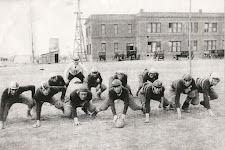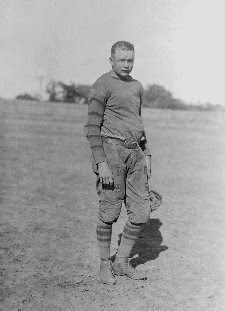 |
| Dumpsters will be located just north of Front and Bois d'Arc Streets. |
There will be three large dumpsters at the location, two for all debris and one for tires. Items which may not be placed in containers are as follows: paint, oil, oil filters, chemical containers, and tree limbs. Air conditioners and refrigerators must be tagged land-fill acceptable. There is no curb service, and since the Spring Clean-Up is for Roscoe residents only, anyone dropping off anything must be prepared to show a City of Roscoe water bill.
For more information, contact City Hall during business hours at 325-766-3871.
--o--
ROSCOE COMMUNITY CENTER TAKING REMODELING BIDS
The Roscoe Community Center is seeking bids until April 1, 2016, for some remodeling work to be done at our building. At this time we are accepting bids for removal of old flooring and staining concrete, general construction, dry wall, painting, and some electrical work.
Anyone interested in seeing the building to prepare a bid, should call Gail Presley at 325-518-4135.
--o--
 |
| Just runnin' in the rain at the Blackland Relays on Friday. |
They likely will get a chance to see how good they are on Saturday when they travel to Hamlin for the Pied Piper Relays.
--o--
It’s another big weekend for Texas Country at the Lumberyard. On Friday, Mike Ryan will be in town for a double header with the Jesse Jennings Band, and on Saturday, Stoney LaRue returns for another big show.
 |
| Jesse Jennings |
 |
| Mike Ryan |
 |
| Stoney LaRue |
Born in Texas but raised in Oklahoma, LaRue is famous for developing the Red Dirt sound along with friends Cody Canada, Jason Boland, and Brandon Jenkins. His 2005 CD, The Red Dirt Album, reached the Billboard sales charts its debut week, and in 2006 he released the best seller Live at Billy Bob’s. In 2011 he achieved acclaim for his 2011 CD, Velvet, and his 2014 album, Aviator. His latest, Us Time, released this past October, is a collection of fan favorites from his live shows. It includes Van Morrison’s “Into the Mystic,” Glen Campbell’s “Wichita Lineman,” and Gary Stewart’s “Empty Glass,” as well as LaRue standards such as “Feet Don’t Touch the Ground,” and “Oklahoma Breakdown,” plus a new LaRue original, “Easy She Comes,” and others. YouTube videos include “Aviator,” and his signature single “Oklahoma Breakdown.”
The Judson Cole Band from San Angelo will open for Stoney LaRue at around 8:00pm. LaRue will take the stage around 9:45pm. For reservations or more information, contact the Lumberyard at 325-766-2457.
--o--
WEATHER REPORT: COOL AND WET, THEN WARM
 |
| The sunset on Thursday. |
Today should be similar with a projected high of 79° and a low of 50°. Tomorrow will be a bit cooler with a high of 68° as winds shift to the northeast and bring a 20% chance of rain. Then Friday and Saturday should be even cooler with highs of 60° and 56° respectively along with an 80% of rain during the day on Friday. Saturday morning’s low is forecast to be only 39°, which will be the lowest we’ve had in a while. On Sunday, the sun should come back out, bringing with it warmer temperatures that will rise daily to mid-week with next Tuesday’s high back up to 84°.
--o--
ROSCOE IN YEARS GONE BY:
RONDO WHORTON'S SOLO FLIGHT
by R. H. Whorton, Jr.
 |
| Lt. Larry Douthit beside Rondo Whorton's Flying Jenny. |
In 1893, Mr. Whorton’s eldest son, D. B., married the daughter of the owner of Roscoe’s first general store. It was Roscoe’s first wedding, and their first son, Ronda Hoyt Whorton, born in 1894, was Roscoe’s second baby. Known as “Rondo,” he went to Roscoe schools and lived his life here. He is the subject of the following account written in the early 1970s by his son, R. H. Whorton, Jr., better known as “Billy.” The story comes from a Whorton family history donated to the Roscoe Historical Museum by a direct descendant of F. M. Whorton, Ronnie Fry, who now lives in Lubbock.
 |
| Rondo Whorton in 1915. |
Rondo, as he was affectionately called, was born May 23, 1894, to D. B. and Willie Belle Whorton at the F. M. Whorton homestead farm just south of Roscoe, Nolan County, Texas. He was the oldest member of a family of three brothers and one sister. He was reared on the farm and attended the Roscoe Schools. In the years that he grew into manhood, marvelous adventures were being developed in the field of transportation and communication. These new ideas intrigued and fascinated him to the point he wanted to be a part of their application to local conditions. He told me of operating silent movie projectors for free so he could learn of their principle. He built crystal radio sets and received signals from Fort Worth and later Abilene.
As a teenager he and his friends would “hop” freight trains and travel over the Texas & Pacific Railway lines. It made no difference which way the train was going as they could always return to Roscoe from Marshall or El Paso via another freight. To him the practical application of electricity in homes was an obsession, and he purchased a set of books from which he could learn the basics of electric science. In later life he used this knowledge to supplement the family farm income by installing electricity in commercial and residential buildings.
The post-World War I years were filled with daring exploits of the young Americans of the roaring twenties. The army during the war had built and found both a practical and a destructive use for the airplane. The combination of surplus airplanes brought on the art of “barnstorming.” Daring young men would buy and fly surplus World War I planes from community to community and “carry up” passengers from the local population.
This type of daring appealed to Rondo, and in 1924 he purchased an army surplus trainer at Love Field, Dallas. The biplane was a wood and fabric Curtiss-Wright with a water cooled OX-5 engine. It was better known as the Flying Jenny. As he could not fly the plane to Roscoe, he engaged a pilot to fly it for him. After leaving Love Field, he and the pilot were forced to land at Ranger for fuel. The pilot on his final approach overshot the landing strip, and since these planes had no brakes, it crashed through a fence and into a mesquite thicket. The pilot returned to Love Field and Rondo to Roscoe via the dependable T&P railroad. The damaged aircraft was left in Ranger in storage.
Rondo frantically wrote suppliers for parts and finally the Curtiss-Wright factory in Akron, Ohio. The factory advised him to rob parts from some other wrecked plane that was damaged beyond repair. The factory also advised if all other efforts failed, the air frame could be repaired by a skilled carpenter but cautioned that the wood must be of the lightest weight available. The plane was repaired and brought to Roscoe to be parked in a pasture just north of the Roscoe, Snyder & Pacific Railway shop.
While awaiting repairs on the airplane, he wrote to Kelly Field in San Antonio, an army training school for pilots, requesting the possibility of some aviator coming to Roscoe to teach him to fly the airplane. His letter was answered by Air Cadet Larry Douthit, who said he was to graduate in a few weeks and he would request a leave of absence for the purpose of coming to Roscoe and teaching Rondo to fly the Jenny. Meanwhile, the airplane at Ranger was repaired, and it and the instructor arrived in Roscoe. We children were quite small, and we were all awed by the Jenny and the army instructor. Rondo and Mary had very recently constructed a new modern house with three bedrooms, and we five children had the luxury of sharing not one but two bedrooms.
The arrival of Lt. Larry Douthit required that we give up the choice front bedroom to him, and we again were allotted cramped quarters. However, he more than made up for this inconvenience by building us kites constructed from balsa wood, fine cotton fabric, and airplane dope. We were the envy of the neighborhood as these kites made from airplane materials were practically indestructible.
After a short period of instruction, Rondo was urging his instructor to let him solo. Lt. Douthit did not believe his pupil was ready and would not allow a solo flight. However, at dawn one morning Rondo very quietly slipped out the back door of the house with his clothes in his hands. I was only about five years of age, but the closing back door awakened me, and I looked from the bedroom and saw my father dressing on the back porch. I hurriedly dressed and slipped outside to find him pushing the family Model T Ford from the garage and down the driveway. Upon seeing me, he motioned me to be quiet and help him push. We pushed the car to the street and about a half block from the house before he started the engine with a hand crank. This was necessary so as not to awaken anyone else in the household.
We then proceeded in the car to the pasture north of Roscoe where the Jenny was staked down. Rondo told me to stay in the car while he took the airplane up for his solo flight. At this point I cried so loud and raised such a big fuss he strapped me in the Jenny’s passenger seat in the front cockpit. He then hand cranked the plane by its propeller and jumped in the pilot’s seat in the rear cockpit. He proceeded to take off from the rough pasture. After flying the plane in a few circles, he flew over the house. After buzzing the house a few times to get the instructor’s attention, he flew very low and dropped a note tied to a pair of pliers.
I don’t recall what the note said, but I can still see the family gathered in the front yard with hands shading their eyes from the early morning sun, watching Rondo solo with his young son as a passenger. Instructor Douthit made quite a sight running back and forth in the street below in pajamas and robe shouting something we could not hear. I did not realize until years later that this act was so daring and so typical of my father.
Lt. Larry Douthit returned to Kelly Field and had a distinguished Air Force career. He retired in about 1960 but made many local friends, and he returned to visit them occasionally. Rondo continued to fly the Jenny until 1926 when he traded it to A. H. Warken of Pyron for a Fordson tractor and an Oliver treble-disk plow. In 1938 he and three other Roscoe men formed a Flying Club and purchased a Piper Super Cruiser and flew it until 1943 when the shortage of aviation gas forced them to sell it. Although he had hundreds of flight hours, he had only an Airman’s Certificate, which was issued him on April 16, 1942, by the Civil Aeronautics Administration.
--o--










No comments:
Post a Comment